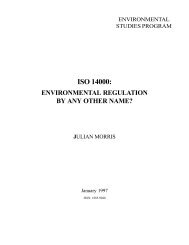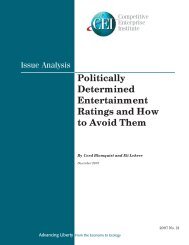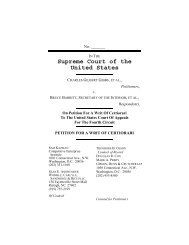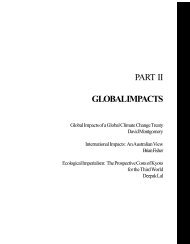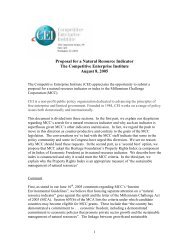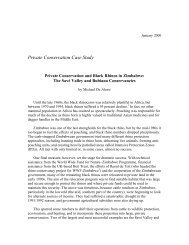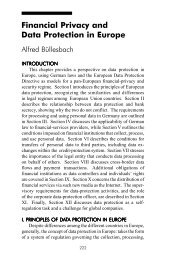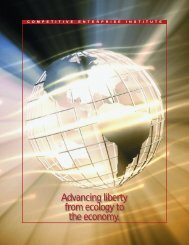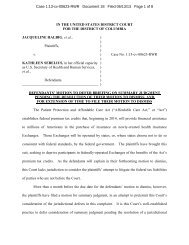global warming and energy policy - Competitive Enterprise Institute
global warming and energy policy - Competitive Enterprise Institute
global warming and energy policy - Competitive Enterprise Institute
Create successful ePaper yourself
Turn your PDF publications into a flip-book with our unique Google optimized e-Paper software.
Global Warming <strong>and</strong> Energy<br />
GLOBAL WARMING AND ENERGY<br />
POLICY<br />
OVERVIEW<br />
Abundant <strong>and</strong> affordable <strong>energy</strong> is one of the great boons of modern industrial civilization <strong>and</strong><br />
the basis of our st<strong>and</strong>ard of living. Energy makes people’s lives brighter, safer, more comfortable, <strong>and</strong><br />
more mobile. Unfortunately, billions of people in poor countries still do not have access to <strong>energy</strong>. For<br />
example, India’s per capita consumption of electricity is one-twentieth of that of the United States.<br />
Hundreds of millions of Indians live “off the grid,” that is without electricity, <strong>and</strong> cow dung is still a major<br />
fuel for household cooking. This continuing reliance on such pre-industrial <strong>energy</strong> sources is also one<br />
of the major causes of environmental degradation.<br />
Whether poor people around the world ever gain access to <strong>energy</strong> depends on a number of<br />
factors, such as the development of secure property rights in poor countries <strong>and</strong> continuing technological<br />
progress. There is, however, one potential obstacle that could thwart any amount of effort to<br />
provide more <strong>energy</strong>. That threat is an international agreement that forces reductions in the consumption<br />
of hydrocarbon fuels. This is because hydrocarbons — coal, petroleum, <strong>and</strong> natural gas —<br />
provide over three-quarters of the world’s total <strong>energy</strong>. Although there are many alternative sources of<br />
<strong>energy</strong>, all of these sources combined cannot begin to substitute for hydrocarbons without further<br />
significant technological innovations <strong>and</strong> massive capital investments. This is not the work of a few<br />
years, but rather of several decades. 1<br />
It may be objected that the Kyoto <strong>global</strong> <strong>warming</strong> treaty only proposes to reduce carbon dioxide<br />
emissions (which are the necessary product of combusting hydrocarbons) produced by alreadyindustrialized<br />
nations. It would therefore not restrict access to hydrocarbon <strong>energy</strong> by poor countries.<br />
This objection is entirely disingenuous. The Kyoto Protocol to the United Nations Framework Convention<br />
on Climate Change was conceived <strong>and</strong> is intended as only the first step toward reducing hydrocarbon<br />
<strong>energy</strong> use worldwide. Without further protocols to reduce carbon dioxide emissions in all<br />
countries, the Kyoto treaty would be pointless.<br />
Support for putting the world on an <strong>energy</strong>-starvation diet in order to avert catastrophic <strong>global</strong><br />
<strong>warming</strong> has continued to gain ground among intellectuals <strong>and</strong> leaders in many countries. At the<br />
same time, however, the scientific case for catastrophic <strong>global</strong> <strong>warming</strong> has been collapsing rapidly,<br />
despite the alarmism promoted by United Nations scientific bureaucrats <strong>and</strong> repeated endlessly by<br />
the major media.<br />
1 For a general discussion of these issues, see Robert L. Bradley, Jr., Julian Simon <strong>and</strong> the Triumph of Energy Sustainability (Washington, D.C.:<br />
American Legislative Exchange Council, 2000).<br />
www.cei.org ✦ <strong>Competitive</strong> <strong>Enterprise</strong> <strong>Institute</strong> ✦ (202) 331-1010<br />
67
THE KYOTO PROTOCOL<br />
The scientific case for <strong>global</strong> <strong>warming</strong> alarmism is shaky <strong>and</strong> becoming shakier. Still, even if<br />
alarmism turns out to be warranted, any possible benefits of the Kyoto <strong>global</strong> <strong>warming</strong> treaty or any<br />
similar <strong>energy</strong>-suppression policies would be dwarfed by the staggering costs.<br />
History of the Treaty<br />
President George Herbert Walker Bush signed the United Nations Framework Convention on<br />
Climate Change (hereafter referred to as the Framework Convention) 1 at the Earth Summit in Rio de<br />
Janeiro in May 1992. Later that year the U.S. Senate ratified the treaty unanimously. It entered into<br />
force on March 21, 1994. 2<br />
The objective of the Framework Convention is “to achieve … stabilization of greenhouse gas<br />
concentrations in the atmosphere that would prevent dangerous anthropogenic interference with the<br />
climate system.” 3 What constitutes “dangerous interference with the climate system” has never been<br />
defined.<br />
The Framework Convention sets no m<strong>and</strong>atory limits on greenhouse gas emissions for individual<br />
nations <strong>and</strong> contains no enforcement provisions. It is therefore considered legally non-binding.<br />
However, the treaty does include provisions for additional protocols that would set m<strong>and</strong>atory emission<br />
limits.<br />
At the Third Conference of the Parties to the Framework Convention on Climate Change (COP-<br />
3), held in Kyoto, Japan in December 1997, participants negotiated a protocol at the urging of the<br />
Clinton-Gore Administration. The Kyoto Protocol sets binding targets <strong>and</strong> timetables for reducing<br />
greenhouse gas emissions for industrialized nations. 4 Binding targets <strong>and</strong> timetables were not set for<br />
developing <strong>and</strong> Third World nations. The Kyoto Protocol will enter into force when 55 nations have<br />
ratified it <strong>and</strong> when Annex I nations listed in the Framework Convention comprising 55 percent of<br />
greenhouse gas emissions in the baseline year of 1990 have ratified it.<br />
The Kyoto Protocol requires Annex I parties to reduce greenhouse gas emissions to an average<br />
of 5.2 percent below 1990 levels by 2008 to 2012. The United States would be required to reduce<br />
emissions to 7 percent below 1990 levels. The European Union’s (EU) target is 8 percent below 1990,<br />
but the EU is allowed to share out these reductions as it pleases among its member countries. Thus<br />
some EU members will be allowed to increase greenhouse gas emissions over 1990 levels, while<br />
others must make reductions larger than 8 percent. 5<br />
The Clinton Administration signed the Kyoto Protocol on November 12, 1998, but did not submit<br />
it to the Senate for ratification. On July 25, 1997, before the Kyoto Protocol was negotiated, the<br />
U.S. Senate passed by a 95-0 vote the Byrd-Hagel Resolution (S. Res. 98), which stated the sense of<br />
the Senate was that it would not ratify any protocol to the Framework Convention that “would result in<br />
serious harm to the economy of the United States” <strong>and</strong> that did not include binding targets <strong>and</strong> time-<br />
1 The web page of the Framework Convention is located at http://www.unfccc.int. Current negotiating texts, a schedule of upcoming meetings, a list of<br />
parties that have ratified the Kyoto Protocol, <strong>and</strong> other information is also available.<br />
2 Full text of the Convention is available at http://www.unfccc.int/resource/conv/index.html.<br />
3 United Nations Framework Convention on Climate Change, Article 2, http://www.unfccc.int/resource/conv/conv_004.html.<br />
4 The Kyoto Protocol is available online at http://www.unfccc.de/resource/docs/convkp/kpeng.html.<br />
5 Ibid.<br />
Global Warming <strong>and</strong> Energy<br />
www.cei.org ✦ <strong>Competitive</strong> <strong>Enterprise</strong> <strong>Institute</strong> ✦ (202) 331-1010<br />
69
70<br />
The Environmental Source<br />
tables for developing as well as industrialized nations. 6 The Kyoto Protocol meets neither of these<br />
conditions.<br />
The Kyoto Protocol was not completed in Kyoto in 1997. Succeeding Conferences of the<br />
Parties have attempted to resolve these remaining uncompleted areas, but so far without success.<br />
Unfinished issues include how to monitor greenhouse gas emissions, what constitutes reductions in<br />
emissions, what means may be used to meet emissions targets, <strong>and</strong> how to enforce the protocol.<br />
Various “flexibility mechanisms” allow nations to meet their emissions limits in ways other than cutting<br />
carbon dioxide emissions, but the parties have not agreed upon the extent to which nations may use<br />
these mechanisms. The flexibility mechanisms include: creating carbon sinks; international emissions<br />
trading; Joint Implementation; <strong>and</strong> the Clean Development Mechanism.<br />
The Bush Administration announced in March 2001 that it opposed the Kyoto Protocol. On<br />
June 11, 2001, President George W. Bush further explained his reasons for considering the Protocol<br />
to be “fatally flawed” <strong>and</strong> also announced alternative actions to address the “serious issue” of <strong>global</strong><br />
<strong>warming</strong>. 7 However, the president did not withdraw the signature of the United States from the Protocol.<br />
COP-6 resumed in Bonn in July 2001. The press reported some progress towards resolving<br />
outst<strong>and</strong>ing issues, but others who attended did not agree that much had been accomplished. 8 Key<br />
leaders declared that they would proceed to ratify the Protocol without U.S. participation. 9<br />
Costs of Not Implementing Kyoto<br />
The United Nations Environment Programme (UNEP) in 2001 estimated that the total <strong>global</strong><br />
costs associated with implementing mitigation measures to address the impacts of <strong>global</strong> <strong>warming</strong> —<br />
such as the building of dams <strong>and</strong> relocation of populations in low-lying areas — would be $300 billion<br />
per year. The U.N.’s Intergovernmental Panel on Climate Change (IPCC) estimates these costs<br />
would be approximately 2 percent of gross domestic product (GDP) in industrialized countries. 10 Yet<br />
neither of these estimates consider the fact that <strong>global</strong> <strong>warming</strong> is also likely to produce benefits —<br />
such as increased food production — that could partially offset the costs. The UNEP’s <strong>and</strong> the IPCC’s<br />
estimate must therefore be considered too high.<br />
The Costs of Global Warming Policies<br />
In contrast, the costs to the U.S. economy of compliance with the Kyoto Protocol have been<br />
estimated at between $225 <strong>and</strong> $440 billion per year:<br />
Charles River Associates, a private economic consulting firm, estimated that the treaty would cost<br />
an estimated $225 billion annually. 11<br />
6 Congressional Record (25 July 1997): S.8114.<br />
7 President George W. Bush, “Remarks By The President On Global Climate Change,” White House Press Release, 11 June 2001, http://<br />
www.whitehouse.gov/news/releases/2001/06/20010611-2.html.<br />
8 See Christopher Horner, “A Heated Letter from Bonn,” Washington Times, 29 July 2001, http://www.cei.org/OpEdReader.asp?ID=1584.<br />
9 William Drozadiak, “U.S. Left Out of Warming Treaty,” Washington Post, 24 July 2001, A1.<br />
10 Tariq Banuri et al., Technical Summary: Climate Change 2001, A Report of Working Group III of the International Panel on Climate Change (Geneva:<br />
IPCC, 2001), http://www.ipcc.ch/pub/wg3TARtechsum.pdf.<br />
11 Charles River <strong>and</strong> Associates, The Post Kyoto Climate: Impacts on the U.S. Economy (Washington, D.C.: Charles River <strong>and</strong> Associates, 1999).<br />
www.cei.org ✦ <strong>Competitive</strong> <strong>Enterprise</strong> <strong>Institute</strong> ✦ (202) 331-1010
WEFA, Inc., another private economic consulting firm, estimated $350 billion annually. 12<br />
A study by the Department of Energy’s Energy Information Administration estimated $440 billion in<br />
Kyoto costs. 13<br />
It’s worth highlighting the fact that these studies only consider costs to the United States, which<br />
produces approximately 25 percent of gross <strong>global</strong> greenhouse gas emissions. Thus, these estimates<br />
only cover 25 percent of the worldwide costs of the treaty. If the average estimated U.S.<br />
compliance cost is $300 billion, <strong>and</strong> the United States constitutes only one-quarter of emissions, then<br />
the total cost of <strong>global</strong> compliance could be roughly four times $300 billion or $1,200 billion annually.<br />
Moreover, the costs of compliance will not offset, but will be in addition to, the costs of <strong>global</strong><br />
<strong>warming</strong> because the Kyoto Protocol would only slow the predicted rate of <strong>global</strong> <strong>warming</strong> by an<br />
insignificant amount. Dr. Tom Wigley, of the National Center for Atmospheric Research <strong>and</strong> a Kyoto<br />
booster, has estimated that the Protocol would reduce the predicted <strong>global</strong> mean temperature in 2050<br />
by two-tenths of a degree Celsius.<br />
The fact is that the possible benefits of the Kyoto Protocol are negligible compared to the<br />
costs. Because the Protocol does so little to slow the rate of predicted <strong>warming</strong>, additional restrictions<br />
on greenhouse gas emissions would be necessary. Supporters of the Protocol have estimated that<br />
greenhouse gas emissions reductions totaling between 10 <strong>and</strong> 30 times those required by the Kyoto<br />
Protocol will be needed to save the planet from the threat of predicted catastrophic <strong>global</strong> <strong>warming</strong>.<br />
Alternative Policies<br />
Global Warming <strong>and</strong> Energy<br />
In the wake of U.S. withdrawal from the Kyoto Protocol, a number of alternative policies are<br />
being proposed. Insofar as their purpose is to suppress the use of carbon-based fuels, these policies<br />
suffer from most of the same defects as the Kyoto Protocol.<br />
For example, “[T]he economic impacts of cap-<strong>and</strong>-trade programs would be similar to those of a<br />
carbon tax: both would raise the cost of using carbon-based fossil fuels, lead to higher <strong>energy</strong><br />
prices, <strong>and</strong> impose costs on users <strong>and</strong> some suppliers of <strong>energy</strong>,” according to a June 2001 study<br />
by the non-partisan Congressional Budget Office.<br />
In fact, the effects of a cap-<strong>and</strong>-trade program could be worse than a carbon tax because<br />
rewarding companies for not producing <strong>energy</strong> will create a powerful lobbying force for further <strong>energy</strong><br />
suppression measures.<br />
So what should we be doing to address potential future <strong>global</strong> <strong>warming</strong>? In the first place, the<br />
federal government should pursue policies that make sense for other reasons whether <strong>global</strong> <strong>warming</strong><br />
occurs or not. For example, the elimination of subsidies that encourage the use of carbon-based<br />
fuels makes sense even without <strong>global</strong> <strong>warming</strong>. 14<br />
12 WEFA, Inc., Global Warming: The High Costs of the Kyoto Protocol, National <strong>and</strong> State Impacts (Washington, D.C.: WEFA, 1998).<br />
13 U.S. Department of Energy, Energy Information Administration, Impacts of the Kyoto Protocol on U.S. Energy Markets <strong>and</strong> Economic Activity (Washington,<br />
D.C.: U.S. DOE, 1998).<br />
14 Jonathan Adler et al., Greenhouse Policy Without Regrets: A Free Market Approach to the Uncertain Risks of Climate Change (Washington, D.C.:<br />
<strong>Competitive</strong> <strong>Enterprise</strong> <strong>Institute</strong>, July 2000), http://www.cei.org/MonoReader.asp?ID=1081.<br />
www.cei.org ✦ <strong>Competitive</strong> <strong>Enterprise</strong> <strong>Institute</strong> ✦ (202) 331-1010<br />
71
72<br />
The Environmental Source<br />
Second, we should pursue the pro-economic growth policies that will enable us to implement<br />
mitigation measures should <strong>global</strong> <strong>warming</strong> cause problems in the future. Such pro-growth policies<br />
are essential particularly for much of the developing world, which lacks the resources to address such<br />
problems today. They not only lack the resources to provide emergency personnel in the case of<br />
natural disasters; they also lack the resources to construct disaster-resistant buildings, flood control<br />
projects, etc. By impeding economic growth, Kyoto promises to hurt, rather than help, nations grow<br />
economically <strong>and</strong> develop such resources. 15<br />
— Myron Ebell<br />
Key Experts<br />
Myron Ebell, CEI, (202) 331-1010, mebell@cei.org.<br />
Paul J. Georgia, CEI, (202) 331-1010, pgeorgia@cei.org.<br />
Christopher C. Horner, CEI, (202) 331-1010, chorner@cei.org.<br />
Recommended Readings<br />
Adler, Jonathan. Editor. The Costs of Kyoto. Washington, D.C.: <strong>Competitive</strong> <strong>Enterprise</strong> <strong>Institute</strong>,<br />
1997, http://www.cei.org/costofkyoto2001.html.<br />
Adler, Jonathan et al. Greenhouse Policy Without Regrets: A Free Market Approach to the Uncertain<br />
Risks of Climate Change. Washington, D.C.: <strong>Competitive</strong> <strong>Enterprise</strong> <strong>Institute</strong>, July 2000, http://<br />
www.cei.org/MonoReader.asp?ID=1081.<br />
Cooler Heads Newsletter. Current <strong>and</strong> back issues are located at www.<strong>global</strong><strong>warming</strong>.org.<br />
Goklany, Indur M. “Richer Is More Resilient: Dealing with Climate Change <strong>and</strong> More Urgent Environmental<br />
Problems.” In Earth Report 2000. Edited by Ronald Bailey, 156-87. N.Y.: McGraw-Hill, 2000.<br />
McKitrick, Ross. Submission to the Joint St<strong>and</strong>ing Committee on Treaties: Inquiry into the Kyoto<br />
Protocol, Parliament of Australia. 26 September 2000, http://www.uoguelph.ca/~rmckitri/research/<br />
australia.pdf.<br />
15 Indur Goklany, “Potential Consequences of Increasing CO2 Concentrations Compared to Other Environmental Problems,” Technology 7s (2000): 189-<br />
213.<br />
www.cei.org ✦ <strong>Competitive</strong> <strong>Enterprise</strong> <strong>Institute</strong> ✦ (202) 331-1010
GLOBAL WARMING SCIENCE<br />
Universities <strong>and</strong> government institutions around the world are engaged in an enormous amount<br />
of scientific research on <strong>global</strong> climate change. This research involves not only the various specialized<br />
disciplines that study the atmosphere <strong>and</strong> the temperature record, but also solar physics, oceanography,<br />
botany, glaciology, paleo-climatology, <strong>and</strong> other related subjects. Yet the major impact of this<br />
research on the public <strong>policy</strong> debate over <strong>global</strong> <strong>warming</strong> does not come directly from the research<br />
itself. Instead, the United Nations’ Intergovernmental Panel on Climate Change (IPCC) issues reports<br />
summarizing <strong>and</strong> interpreting recent climate research. The IPCC’s official pronouncements are touted<br />
by the media <strong>and</strong> become part of conventional wisdom. The problem is that the IPCC is driven by<br />
political goals, which puts a consistent slant on everything it produces. Consequently, its public pronouncements<br />
are usually misleading <strong>and</strong> often inaccurate.<br />
The IPCC Process<br />
Global Warming <strong>and</strong> Energy<br />
Over the past decade, the IPCC has prepared three Assessment Reports which summarize<br />
<strong>and</strong> evaluate the entire range of recent climate research. The Third Assessment Report (or TAR) was<br />
published in 2001 by Cambridge University Press in three huge volumes, one for each of the IPCC’s<br />
three Working Groups (Science, Impacts, <strong>and</strong> Mitigation). 1<br />
Some months before the three Working Group reports received final approval, the IPCC prepared<br />
a brief “Summary for Policymakers” of each report. It is these three highly selective 15 to 20<br />
page Summaries that largely inform the public <strong>policy</strong> debate over <strong>global</strong> <strong>warming</strong>. 2<br />
IPCC officials claim <strong>and</strong> media subsequently report that the Assessment Reports <strong>and</strong> their<br />
Summaries represent the consensus views of the hundreds of scientists who have contributed to the<br />
reports. This claim is false. Each chapter of an Assessment Report is written by a team of authors,<br />
consisting of a coordinating lead author, lead authors, <strong>and</strong> many contributing authors. Contributors<br />
are each responsible for a small section, as short as one or two pages. Contributors are not asked by<br />
the IPCC whether they agree with anything else in the Assessment Report beyond their own small<br />
sections.<br />
Teams of 15 to 25 people consisting of chapter lead authors <strong>and</strong> other IPCC officials prepare<br />
the Summaries for Policymakers. Their drafts are edited <strong>and</strong> then approved by representatives of the<br />
national governments that comprise the IPCC. As such, the Summaries reflect the political agenda of<br />
the proponents of <strong>global</strong> <strong>warming</strong> alarmism <strong>and</strong> often slant the content in that direction. Such reports<br />
are responsible for many of the myths about the science of <strong>global</strong> <strong>warming</strong>. The following section<br />
discusses some of the key myths promoted by the IPCC Summary for Policymakers of the Third<br />
Assessment Report’s Working Group 1 as well as some other common myths.<br />
1 J. T. Houghton et al., ed., Climate Change 2001: The Scientific Basis: Contribution of Working Group I to the Third Assessment Report of the<br />
Intergovernmental Panel on Climate Change, Cambridge, Engl<strong>and</strong>: Cambridge UP, 2001. James J. McCarthy et al., ed., Climate Change 2001:<br />
Impacts, Adaptation & Vulnerability: Contribution of Working Group II to the Third Assessment Report of the Intergovernmental Panel on Climate<br />
Change, Cambridge, Engl<strong>and</strong>: Cambridge University Press, 2001. Bert Metz, Ogunlade Davidson, Rob Swart <strong>and</strong> Jiahua Pan ed., Climate Change<br />
2001: Mitigation: Contribution of Working Group III to the Third Assessment Report of the Intergovernmental Panel on Climate Change, Cambridge,<br />
Engl<strong>and</strong>: Cambridge University Press, 2001.<br />
2 United Nations, Summaries for Policymakers, Working Group I, http://www.ipcc.ch/pub/spm22-01.pdf; Working Group II available at http://<br />
www.ipcc.ch/pub/wg2SPMfinal.pdf; Working Group III available at http://www.ipcc.ch/pub/wg3spm.pdf.<br />
www.cei.org ✦ <strong>Competitive</strong> <strong>Enterprise</strong> <strong>Institute</strong> ✦ (202) 331-1010<br />
73
74<br />
The Environmental Source<br />
Myth: The Last Century Was the Warmest in a Millennium<br />
The Third Assessment Report’s Working Group 1 Summary includes a graph that shows nearly<br />
stable <strong>global</strong> mean temperatures for the first 900 years of the past millennium <strong>and</strong> then a sharp<br />
increase in temperature during the 20th century. This “hockey stick” graph is the basis of the frequent<br />
claim that the last century was the warmest in the past thous<strong>and</strong> years.<br />
This assertion is based on only one scientific article that compiled <strong>and</strong> analyzed only one set of<br />
tree rings out of the numerous paleo-climate data sets available. 3 A wealth of research beginning with<br />
the father of modern climatology, Hubert H. Lamb, indicates that the Medieval Warm Period (from<br />
around 800 to 1200) was <strong>global</strong> <strong>and</strong> that <strong>global</strong> mean temperatures were higher than during the 20th<br />
century. 4 The hockey stick also fails to show the Little Ice Age from around 1300 to 1850. Much<br />
research suggests that the Little Ice Age was the coldest period since the end of the last Ice Age<br />
11,000 years ago. 5 These errors in the hockey stick graph undermine the credibility of the claim that<br />
the 20th century was the warmest in the past millennium.<br />
Myth: Global Warming Models Are Becoming More Accurate<br />
Much of <strong>global</strong> <strong>warming</strong> theory is based on <strong>global</strong> <strong>warming</strong> computer models that have built-in<br />
assumptions about how various changes in the atmosphere could affect weather. These models have<br />
consistently failed to adequately predict changes in climate because limited knowledge inhibits the<br />
scientific community’s ability to account for all possible factors. Regarding these models, the Third<br />
Assessment’s Summary claims that:<br />
“Confidence in the ability of models to project future climate has increased. Underst<strong>and</strong>ing of<br />
climate processes <strong>and</strong> their incorporation in climate models have improved, including water vapour,<br />
sea-ice dynamics, <strong>and</strong> ocean heat transport.” 6<br />
Yet Dr. Richard S. Lindzen, professor of meteorology at MIT <strong>and</strong> a lead author of Chapter 7 of<br />
the TAR, commented on this claim:<br />
“This statement summarizes a chapter which points out that all these things are done poorly,<br />
<strong>and</strong> that no model comes close to realistically depicting clouds. Moreover, clouds <strong>and</strong> water<br />
vapor are so intimately related that it is inconceivable that one would get water vapor right <strong>and</strong><br />
clouds wrong. It also ignores that it is the behavior of water vapor <strong>and</strong> clouds (the atmosphere’s<br />
main greenhouse substances) are responsible for model predictions of large <strong>warming</strong>. Increased<br />
CO 2 alone, will produce little <strong>warming</strong> (about 1 degree Celsius for a doubling of CO 2 ).<br />
This point is made in Chapter 7.” 7<br />
3 Michael E. Mann, Raymond S. Bradley, <strong>and</strong> Malcolm K. Hughes, “Northern Hemisphere Temperatures During the Last Millennium: Inferences,<br />
Uncertainties, <strong>and</strong> Limitations,” Geophysical Research Letters, no. 26 (March 15, 1999): 759.<br />
4 H. H. Lamb, Climate History <strong>and</strong> the Modern World (New York: Routledge, 1985).<br />
5 Brian Fagan, The Little Ice Age: How Climate Made History, 1300-1850 (New York: Basic Books, 2000).<br />
6 International Panel on Climate Change, United Nations, Working Group I, Summary for Policymakers (Geneva: IPCC, 2001), http://www.ipcc.ch/<br />
pub/spm22-01.pdf.<br />
7 Richard S. Lindzen, Cooler Heads Coalition Briefing (Washington, D.C.: <strong>Competitive</strong> <strong>Enterprise</strong> <strong>Institute</strong>, 1 March 2001). Significant research on<br />
water vapor <strong>and</strong> clouds published since completion of the TAR is Richard S. Lindzen, Ming-Dah Chou, <strong>and</strong> Arthur Y. Hou, “Does the Earth Have an<br />
Adaptive Infrared Iris?,” Bulletin of the American Meteorological Society 82, March 2001.<br />
www.cei.org ✦ <strong>Competitive</strong> <strong>Enterprise</strong> <strong>Institute</strong> ✦ (202) 331-1010
Global Warming <strong>and</strong> Energy<br />
Myth: Humans Are Key Cause of Warming<br />
The IPCC Summary observes that the <strong>global</strong> mean temperature increased by three-tenths of<br />
one degree Celsius in the second half of the 20th century, <strong>and</strong> then it claims: “There is new <strong>and</strong><br />
stronger evidence that most of the <strong>warming</strong> observed over the last 50 years is attributed to human<br />
activities.” 8 This claim is contradicted by a report published in 2000 by the National Research Council<br />
(NRC) on Reconciling Observations on Global Temperature Change. 9 The NRC’s special committee<br />
concluded that surface temperature data showing a three-tenths of a degree Celsius rise in the <strong>global</strong><br />
mean temperature since 1975 was accurate, but so too was the satellite temperature record compiled<br />
by scientists John Christy <strong>and</strong> Roy Spencer. 10 Their satellite measurements show no significant increase<br />
in <strong>global</strong> mean temperature from 1979 to the present. Satellites measure temperatures in the<br />
lower troposphere. According to <strong>global</strong> <strong>warming</strong> theory, an increase in the greenhouse effect will first<br />
raise temperatures in the atmosphere, which will then warm the earth’s surface. Therefore, the observed<br />
surface <strong>warming</strong> during the second half of the 20th century cannot plausibly be attributed to<br />
increasing greenhouse concentrations.<br />
Myth: Global Temperatures Will Increase by 1.4 to 5.8 Celsius<br />
According to the IPCC Summary, “The <strong>global</strong> average surface temperature is projected to<br />
increase by 1.4 to 5.8 degrees Celsius over the period 1990 to 2100. These results are for the full<br />
range of 35 SRES [Special Report Emission Scenario] scenarios, based on a number of climate<br />
models.” 11 The Second Assessment Report predicted temperature rises in the range of 1 to 3.5<br />
degrees Celsius over the next 100 years. The Summary of the Third Assessment Report reaches a<br />
much higher prediction of 5.8 degrees Celsius (or 10.4 degrees Farenheight) by concocting a completely<br />
implausible scenario consisting of the assumptions that the whole world will raise its level of<br />
economic activity to that of the United States, will equal U.S. per capita <strong>energy</strong> consumption, <strong>and</strong><br />
<strong>energy</strong> use will continue to be carbon intensive. Footnote 11 to the IPCC Summary adds: “This range<br />
does not include uncertainties in the modeling of radiative forcing, e.g. aerosol forcing uncertainties.”<br />
12<br />
But the uncertainties regarding aerosol forcing 13 are so large as to make the predictions entirely<br />
unreliable. The IPCC does not assign probabilities to the range of predicted temperature increases.<br />
A study conducted by researchers at the Joint Program on the Science <strong>and</strong> Policy of Global<br />
Change at MIT concluded that “there is far less than a 1 in 100 chance of a <strong>global</strong> mean surface<br />
temperature increase by 2100 as large as 5.8 degrees Celsius.” They also concluded that “there is a<br />
12 percent chance that the temperature change in 2100 would be less than the IPCC lower estimate.”<br />
14 In other words, there is a 12 percent chance the climate change will be less than 1.4 degrees<br />
8 IPCC, Working Group I, Summary for Policymakers, 10.<br />
9 National Research Council, Reconciling Observations of Global Temperature Change (Washington, D.C.: NRC, 2000), http://bob.nap.edu/books/<br />
0309068916/html.<br />
10 See the Earth System Science Center, Dr. John Christy, Director, http://www.atmos.uah.edu/essl.<br />
11 IPCC, Working Group I, Summary for Policymakers, 13.<br />
12 Ibid.<br />
13 Aerosol forcing is one of the least understood areas of climate research. The IPCC’s Second Assessment Report concluded that anthropogenic<br />
<strong>warming</strong> was being masked by sulfate aerosols, which have a cooling (that is, negative forcing) effect. More recently, it has been suggested that<br />
black carbon aerosols, such as soot, are a major positive (that is, <strong>warming</strong>) forcing agent. See Mark Z. Jacobson, “Strong Radiative Heating Due to<br />
the Mixing State of Black Carbon in Atmospheric Aerosols,” Nature 409 (8 February 2001): 695-72. See also, James D. Hansen, Makiko Sato,<br />
Andrew Lacis, <strong>and</strong> Valdir Oinas, “Global Warming in the Twenty-First Century: An Alternative Scenario,” Proceedings of the National Academy of<br />
Sciences 97, 9,875-80.<br />
14 Massachusetts <strong>Institute</strong> of Technology, Joint Program on the on the Science <strong>and</strong> Policy of Global Change, Uncertainty Analysis of Global Climate<br />
Projections (Cambridge, Mass: MIT, March 2001), http://web.mit.edu/<strong>global</strong>change/www/rpt73.html.<br />
www.cei.org ✦ <strong>Competitive</strong> <strong>Enterprise</strong> <strong>Institute</strong> ✦ (202) 331-1010<br />
75
76<br />
The Environmental Source<br />
Celsius even using the highly questionable assumptions in the IPCC’s computer models.<br />
Myth: Sea Levels Will Rise Dramatically<br />
Global <strong>warming</strong> doomsayers have long claimed that as the earth warms, the Antarctic <strong>and</strong><br />
Greenl<strong>and</strong> ice caps will melt, increasing sea levels. Some have predicted that the water will rise so<br />
high that coastal cities such as New York will soon become submerged in water.<br />
Sea levels have been rising at varying rates since before the end of the last Ice Age 11,000<br />
years ago — long before any manmade <strong>global</strong> <strong>warming</strong> is claimed to have begun. Sea levels will<br />
continue to rise until the next Ice Age begins as the Antarctic <strong>and</strong> Greenl<strong>and</strong> Ice Sheets <strong>and</strong> glaciers<br />
continue to melt. Sea level rise over short periods is extremely difficult to determine, but it is believed<br />
that the rate of sea level rise has not increased over the past century when manmade <strong>global</strong> <strong>warming</strong><br />
is claimed to have occurred. Future <strong>global</strong> <strong>warming</strong> may cause the rate of sea level rise to increase<br />
due to the thermal expansion of water <strong>and</strong> faster melting of the ice sheets.<br />
Fortunately, if there is a sea level rise, we will be able to address associated problems. A<br />
report by the Pew Center on Climate Change, a booster group for <strong>energy</strong> suppression policies, estimated<br />
that the cost of rising sea levels for the United States would total $20 to $150 billion over the<br />
next 100 years. 15 This is less than Americans currently spend on cat food per year ($4 billion). 16 But<br />
more importantly, the estimated costs of mitigating a potential sea rise are hundreds of times less than<br />
estimated costs of <strong>global</strong> <strong>warming</strong> policies. The Kyoto Protocol cost estimates to the United States<br />
range from $225 to $400 billion annually, <strong>and</strong> the Protocol will do little to slow the rate of predicted<br />
<strong>global</strong> <strong>warming</strong>. 17<br />
Myth: Global Warming Will Produce More Storms<br />
Another warning is that <strong>global</strong> <strong>warming</strong> will cause more frequent or more intense severe weather<br />
events, such as hurricanes, droughts, <strong>and</strong> floods. There is no scientific basis to support this claim. Dr.<br />
William Gray, a Colorado State University scientist <strong>and</strong> one of the world’s foremost hurricane experts,<br />
does not believe that <strong>global</strong> <strong>warming</strong> is affecting hurricanes: “It sure as hell ain’t <strong>global</strong> <strong>warming</strong>,” he<br />
bluntly noted on MSNBC. 18<br />
That severe weather events are becoming more common is based on the rise of 24-hour<br />
television news cable channels <strong>and</strong> consequent increased television coverage of weather disasters.<br />
The claim that damages caused by hurricanes have increased is misleading. Insurance claims for<br />
hurricane damage have increased because the number <strong>and</strong> value of buildings in hurricane-prone<br />
areas such as Florida has increased dramatically. Moreover, insurance claims have not increased as<br />
a percentage of gross domestic product. 19<br />
Myth: Global Warming Will Produce More Tropical Diseases<br />
Global <strong>warming</strong> scaremongers also claim that climate changes will increase tropical diseases,<br />
15 James Neumann, Gary Yohe, Robert Nicholls, <strong>and</strong> Michelle Manion, Sea Level Rise & Global Climate Change: A Review of Impacts on U.S.<br />
Coasts (Arlington, Va.: Pew Center on Global Climate Change, February 2000), http://www.pewclimate.org/projects/env_sealevel.cfm.<br />
16 Erin Murphy, “Corn Chips, Kibble or Cat Food,” Cats Magazine, July 2001, http://www.catsmag.com/July2001/feature.html.<br />
17 See brief “Kyoto Protocol” in this book.<br />
18 Miguel Llanos, “Humans <strong>and</strong> Hurricanes Too Simplistic,” MSNBC, 10 January 1998, http://www.msnbc.com/news/106343.asp.<br />
19 Tillinghast-Towers Perrin Inc., “Towers Perrin Hurricane Study Refutes Claims That Global Warming Caused Increased Catastrophic Hurricane<br />
Damages,” Press Release, http://www.towers.com/towers_news/news/press/news_frame_towers.asp?target=../PressRelease_2001/pr071101.htm.<br />
www.cei.org ✦ <strong>Competitive</strong> <strong>Enterprise</strong> <strong>Institute</strong> ✦ (202) 331-1010
Global Warming <strong>and</strong> Energy<br />
bringing them into non-tropical areas. But the fact that such diseases are not common in the Western<br />
world now has nothing to do with climate. Instead, as Western nations grew wealthier, we developed<br />
measures to protect against the disease carrying insects <strong>and</strong> other vectors. 20 Such measures include<br />
the use of tightly enclosed homes with screens <strong>and</strong> air conditioning (keeping bugs out) <strong>and</strong> vector<br />
control, including the use of pesticides.<br />
In fact, before such measures were implemented, so-called “tropical diseases” such as malaria<br />
<strong>and</strong> dengue fever were common during the Little Ice Age in cities as far north as Washington,<br />
New York City, Toronto, London, <strong>and</strong> Stockholm. They were eradicated or controlled in these areas by<br />
public health measures <strong>and</strong> vector control. Major research by Dr. Paul Reiter of the U.S. Centers for<br />
Disease Control <strong>and</strong> Prevention concludes that potential <strong>global</strong> <strong>warming</strong> will not increase the frequency<br />
or range of these diseases. 21 However, these diseases are still common in many poor tropical<br />
<strong>and</strong> sub-tropical countries because of the lack of adequate public health establishments, <strong>and</strong> because<br />
they lack the wealth that enables those in the Western world to avoid contact with disease-carrying<br />
organisms.<br />
What is the Greenhouse Effect?<br />
The greenhouse effect should not be confused with anthropogenic (human-caused) <strong>global</strong><br />
<strong>warming</strong>. Instead, the greenhouse effect is a natural process that keeps the Earth warm enough to<br />
sustain life. Certain gases in the atmosphere (conveniently called greenhouse gases) trap some<br />
incoming solar radiation, which in turn warms the earth’s surface. Most of the heat trapped by the<br />
greenhouse effect is stored in the oceans rather than in the atmosphere.<br />
The principal greenhouse gas is water vapor (which includes clouds). Water vapor constitutes<br />
more than 95 percent of total greenhouse gases. Trace greenhouse gases include carbon<br />
dioxide (CO 2 ), methane (CH 4 ), nitrous oxide (N 2 O), hydrofluorocarbons (HFCs), perfluorocarbons<br />
(PFCs), <strong>and</strong> sulfur hexafluoride (SF 6 ). Water vapor is not included in the UN Framework Convention<br />
on Climate Change <strong>and</strong> Kyoto Protocol because the direct human impact on the amount of<br />
water vapor in the atmosphere is thought to be insignificant. All the trace greenhouse gases are<br />
covered by the Kyoto Protocol, but the principal focus is on reducing carbon dioxide emissions.<br />
Carbon dioxide is a naturally-occurring, tasteless, odorless gas. Plants require carbon<br />
dioxide for photosynthesis. Animals produce CO 2 when they oxidize nutrients <strong>and</strong> exhale. At the<br />
beginning of the Industrial Revolution in the early 19th century, the Earth’s atmosphere contained<br />
approximately 280 parts per million (ppm) of CO 2 . As a result of burning hydrocarbons (coal,<br />
petroleum, <strong>and</strong> natural gas), CO 2 levels have risen to approximately 370 ppm today. 22<br />
The pre-industrial CO 2 level of 280 ppm should not be taken as the normal or preferred<br />
level or the natural background level. CO 2 concentrations have fluctuated widely over geologic<br />
time. Recent research by Dr. Gregory J. Retallack indicates that CO 2 levels have fluctuated between<br />
1,000 <strong>and</strong> 2,000 ppm over most of the past 300 million years <strong>and</strong> have only rarely declined<br />
to the current level. 23<br />
20 Public health officials have raised concerns about expansion of infectious diseases. However, rather than <strong>global</strong> <strong>warming</strong>, they warn that<br />
government regulation of pesticides is hindering their ability to control the insects, rodents, <strong>and</strong> other vectors that transmit such disease. In addition<br />
to regulatory impediments to control, an increase in infectious diseases has grown with the expansion of international travel <strong>and</strong> trade, which enables<br />
disease to migrate along with travelers <strong>and</strong> cargo. For more information on this topic see “Pesticides <strong>and</strong> Public Health” in The Environmental<br />
Source.<br />
21 Paul Reiter, “Climate Change <strong>and</strong> Mosquito Borne Disease,” Environmental Health Perspectives 109, Supp. 1, (March 2001), http://<br />
ehpnet1.niehs.nih.gov/docs/2001/suppl-1/141-161reiter/abstract.html; see also Paul Reiter, “Global Warming And Vector-Borne Disease: Is Warmer<br />
Sicker?” Cooler Heads Briefing (Washington, D.C.: <strong>Competitive</strong> <strong>Enterprise</strong> <strong>Institute</strong>, 28 July 1998), http://www.cei.org/CHBReader.asp?ID=539.<br />
22 For a more detailed description see Kenneth Green, A Plain English Guide to Climate Change (Los Angeles: Reason Public Policy <strong>Institute</strong>, August<br />
2000), http://www.rppi.org/environment/peg3.html.<br />
23 Gregory J. Retallack, “A 300-Million Year Record of Atmospheric Carbon Dioxide from Fossil Plant Cuticles,” Nature (17 May 2001): 287-289.<br />
www.cei.org ✦ <strong>Competitive</strong> <strong>Enterprise</strong> <strong>Institute</strong> ✦ (202) 331-1010<br />
77
78<br />
The Environmental Source<br />
Myth: The Impacts of Global Warming Are All Negative<br />
Global <strong>warming</strong> alarmism depends on the belief that the effects of human-caused climate<br />
change must be entirely bad. However, ecologists <strong>and</strong> economists are rapidly discovering that <strong>global</strong><br />
<strong>warming</strong> could bring both beneficial <strong>and</strong> harmful effects. According to Yale University Professor Robert<br />
Mendelsohn, there has been a:<br />
“[N]ear revolution that has occurred over the past decade in our underst<strong>and</strong>ing of the<br />
impacts of climate change …The new research suggests that climate <strong>warming</strong> will not<br />
be as harmful as we once thought it might be …The reduction in damage-estimates<br />
removes the urgency to engage in costly crash abatement programs. Our initial perspective<br />
on greenhouse gases suggested that we were rapidly approaching the edge<br />
of a cliff. Those fears now appear unfounded, for the impacts from climate <strong>warming</strong><br />
seem to be relatively small for the next century … These changes [in our underst<strong>and</strong>ing<br />
of climate change] are so dramatic that it is not clear whether the net economic<br />
effects from climate change over the next century will be harmful or helpful.” 24<br />
The most certain effect of rising carbon dioxide levels in the atmosphere is not <strong>global</strong> <strong>warming</strong>,<br />
but increased plant growth — leading to higher agricultural yields <strong>and</strong> more food to feed the world <strong>and</strong><br />
greater biodiversity. Plants require carbon dioxide for photosynthesis. Most classes of plants developed<br />
when CO levels were much higher than today. Hundreds of experiments conducted over the<br />
2<br />
past half century have demonstrated increased plant growth with higher CO levels. 2 25 The pre-industrial<br />
CO level is not necessarily the normal or preferred level. 2 26<br />
— Myron Ebell<br />
Key Experts<br />
Myron Ebell, CEI, (202) 331-1010, mebell@cei.org.<br />
Paul J. Georgia, CEI, (202) 331-1010, pgeorgia@cei.org.<br />
Christopher C. Horner, CEI, (202) 331-1010, chorner@cei.org.<br />
Recommended Readings<br />
Baliunas, Sallie L. <strong>and</strong> Willie Soon. Increasing Carbon Dioxide <strong>and</strong> Global Climate Change.<br />
Washington, D. C.: George C. Marshall <strong>Institute</strong>, http://www.marshall.org/baliunasweeds.htm.<br />
Cooler Heads Newsletter. Current <strong>and</strong> back issues are located at www.<strong>global</strong><strong>warming</strong>.org.<br />
24 Robert Mendelsohn, The Greening of Global Warming (Washington, D.C.: American <strong>Enterprise</strong> <strong>Institute</strong>, 1999).<br />
See also Robert Mendelsohn <strong>and</strong> James E. Neumann, The Impact of Climate Change on the United States Economy (Cambridge: Cambridge<br />
University Press, 1999).<br />
25 Sylvan Wittwer, Food, Climate, <strong>and</strong> Carbon Dioxide (Boca Raton, FL: CRC Press), 1995. See also Sherwood Idso, CO2 <strong>and</strong> the Biosphere: The<br />
Incredible Legacy of the Industrial Revolution (St. Paul, MN: University of Minnesota Press, 1995). A wealth of information on current research can<br />
also be found in CO 2 Science Magazine, http://www.co2science.org.<br />
26 See text box: “What is the Greenhouse Effect?”<br />
www.cei.org ✦ <strong>Competitive</strong> <strong>Enterprise</strong> <strong>Institute</strong> ✦ (202) 331-1010
Global Warming <strong>and</strong> Energy<br />
Davis, Robert W. <strong>and</strong> David Legates. “How Reliable Are Climate Models?” Cooler Heads Coalition<br />
Briefing. Washington, D.C.: <strong>Competitive</strong> <strong>Enterprise</strong> <strong>Institute</strong>, 5 June 1998, http://www.cei.org/<br />
CHBReader.asp?ID=471.<br />
Georgia, Paul. “Latest Global Warming Report Already Obsolete,” CEI On Point #81. Washington,<br />
D.C.: <strong>Competitive</strong> <strong>Enterprise</strong> <strong>Institute</strong>,16 May 2001, http://www.cei.org/OnPointReader .asp?ID=<br />
1477.<br />
Adler, Jonathan, editor. The Costs of Kyoto. Washington, D.C.: <strong>Competitive</strong> <strong>Enterprise</strong> <strong>Institute</strong>,<br />
1997, htpp://www.cei.org/costofkyoto2001.html.<br />
Lindzen, Richard S. “Global Warming: The Origin <strong>and</strong> Nature of the Alleged Scientific Consensus.”<br />
Regulation 15, no. 2 (1992), http://www.cato.org/pubs/regulation/reg15n2g.html.<br />
Mendelsohn, Robert. The Greening of Global Warming. Washington, D.C.: The American<br />
<strong>Enterprise</strong> <strong>Institute</strong> Press, 1999.<br />
Michaels, Patrick J. <strong>and</strong> Robert C. Balling Jr., The Satanic Gases. Washington, D.C.: Cato<br />
<strong>Institute</strong>, 2000.<br />
Moore, Thomas G. Climate of Fear: Why We Shouldn’t Worry About Global Warming. Washington,<br />
D.C.: Cato <strong>Institute</strong>, 1998.<br />
Singer, Fred S. Hot Talk, Cold Science: Global Warming’s Unfinished Debate. Oakl<strong>and</strong>, Calif.:<br />
The Independent <strong>Institute</strong>, Revised Edition, 1999.<br />
Reinstein, Robert. “Emission Credits: The Supply <strong>and</strong> Dem<strong>and</strong> Gap.” Cooler Heads Coalition<br />
Briefing. <strong>Competitive</strong> <strong>Enterprise</strong> <strong>Institute</strong>. 23 October 1998, http://cei.org/<br />
CHBReader.asp?ID=508.<br />
Reiter, Paul. “Global Warming And Vector-Borne Disease: Is Warmer Sicker?” Cooler Heads<br />
Coalition Briefing. Washington, D.C.: <strong>Competitive</strong> <strong>Enterprise</strong> <strong>Institute</strong>, 28 July 1998, http://<br />
www.cei.org/CHBReader.asp?ID=539.<br />
Spencer, Roy. “How Do We Know the Temperature of The Earth.” In Earth Report 2000. Edited<br />
by Ronald Bailey, 23-39. New York: McGraw-Hill, 2000.<br />
World Climate Report Newsletter, http://www.greeningearthsociety.org/climate.<br />
www.cei.org ✦ <strong>Competitive</strong> <strong>Enterprise</strong> <strong>Institute</strong> ✦ (202) 331-1010<br />
79
AUTOMOBILE FUEL ECONOMY STANDARDS<br />
The federal government’s new car fuel-economy st<strong>and</strong>ards are a prime example of a program<br />
whose unintended side effects far outweigh its regulatory goals. The program, popularly known as<br />
CAFE (Corporate Average Fuel Economy), was enacted in 1975 in the wake of the Middle East oil<br />
shocks. Its purpose was to reduce our consumption of gasoline <strong>and</strong> dependence on foreign oil by<br />
regulating the fuel efficiency of new cars.<br />
CAFE has increased the fuel economy of new cars, though not to the extent claimed by its<br />
proponents. Nonetheless, its impact on overall gasoline consumption has been minimal because of a<br />
number of offsetting factors. By restricting the availability of large passenger cars, CAFE has boosted<br />
consumer dem<strong>and</strong> for even less fuel-efficient vehicles such as vans <strong>and</strong> sport utility vehicles (SUVs).<br />
Moreover, higher fuel efficiency itself tends to stimulate more driving by reducing the cost of additional<br />
mileage.<br />
Its most notable effect, however, is one that its proponents tend to avoid confronting. By<br />
causing new cars to be downsized (cars are smaller <strong>and</strong> lighter than they otherwise would be), CAFE<br />
makes such cars less crashworthy. The end result is that CAFE has increased traffic fatalities by<br />
2,000 or more deaths per year. 1<br />
The goal of reducing gasoline consumption is itself highly questionable. People derive benefits<br />
from using natural resources. In the case of gasoline <strong>and</strong> vehicle use, mobility allows us to better<br />
structure our lives. It gives us flexibility in choosing our communities <strong>and</strong> our jobs, <strong>and</strong> it aids us in<br />
h<strong>and</strong>ling our family <strong>and</strong> professional responsibilities. So long as the price we pay for gasoline at the<br />
pump is not subsidized by government, any attempt to restrict our mobility should be subject to serious<br />
question. And if government is going to restrict gasoline consumption, then higher gasoline taxes are<br />
the most politically honest way of doing so, since their magnitude is readily apparent to the public.<br />
CAFE’s effects, on the other h<strong>and</strong>, are relatively invisible. That is what makes the program so attractive<br />
to politicians <strong>and</strong> regulatory advocates, <strong>and</strong> so dangerous for the public at large.<br />
Background<br />
Global Warming <strong>and</strong> Energy<br />
CAFE established an initial series of congressionally m<strong>and</strong>ated fuel-economy st<strong>and</strong>ards for<br />
the new-car fleet through 1980, with an eventual goal of 27.5 mpg for 1985. It authorized the Department<br />
of Transportation (DOT) to set the st<strong>and</strong>ards for intervening <strong>and</strong> subsequent years, <strong>and</strong> also to<br />
establish fuel-economy st<strong>and</strong>ards for light trucks. The current new-car st<strong>and</strong>ard has remained at 27.5<br />
mpg since the 1990 model year; for light trucks (which include vans <strong>and</strong> SUVs), the st<strong>and</strong>ard is 20.7<br />
mpg. These st<strong>and</strong>ards must be met by every carmaker’s sales of new vehicles within a given model<br />
year. Individual cars <strong>and</strong> light trucks can fall below the st<strong>and</strong>ard, but they must be offset by a carmaker’s<br />
sales of other vehicles that exceed the st<strong>and</strong>ard.<br />
The Clinton administration generally favored higher CAFE st<strong>and</strong>ards, but a series of congressional<br />
appropriations freezes kept DOT from raising them. The Bush administration, on the other<br />
1 The foremost analysis of this issue can be found in R. W. Cr<strong>and</strong>all <strong>and</strong> J. D. Graham, “The Effect of Fuel Economy St<strong>and</strong>ards on Automobile Safety,”<br />
Journal of Law <strong>and</strong> Economics 32 (April 1989): 97-118. For other analyses that come to similar conclusions, see National Highway Traffic Safety<br />
Administration, Relationship of Vehicle Weight to Fatality <strong>and</strong> Injury Risk in Model Year 1985-93 Passenger Cars <strong>and</strong> Light Trucks (Washington, D.C.:<br />
NHTSA, April 1997); “Death by the Gallon,” USA Today, 2 July 1999, Section B. For an application of the Cr<strong>and</strong>all-Graham analysis to recent traffic<br />
statistics, see Julie DeFalco, The Deadly Effects of Fuel Economy St<strong>and</strong>ards (Washington, D.C.: <strong>Competitive</strong> <strong>Enterprise</strong> <strong>Institute</strong> 1999), http://cei.org/<br />
MonoReader.asp?ID=761.<br />
www.cei.org ✦ <strong>Competitive</strong> <strong>Enterprise</strong> <strong>Institute</strong> ✦ (202) 331-1010<br />
81
82<br />
The Environmental Source<br />
h<strong>and</strong>, is unlikely to push for significantly higher CAFE st<strong>and</strong>ards. Nonetheless, arguments concerning<br />
oil consumption <strong>and</strong> its relationship to the alleged <strong>global</strong> <strong>warming</strong> crisis make it likely that CAFE will<br />
continue to be a highly contentious issue.<br />
Much of the debate in recent years has centered on the appropriate levels that CAFE st<strong>and</strong>ards<br />
should reach. The real issue, however, is the wisdom of the CAFE program itself. As the<br />
following reasons indicate, CAFE’s underlying premises are in need of basic reconsideration.<br />
CAFE Does Not Reduce Gasoline Consumption<br />
Since the passage of CAFE st<strong>and</strong>ards, the fuel efficiency of new cars has nearly doubled.<br />
Much of this increase, however, is due not to CAFE but to the auto market’s response to rising oil<br />
prices. In the years immediately following CAFE’s enactment, new-car fuel economy increased to<br />
levels even higher than those required by statute, as consumers, faced with steadily rising gasoline<br />
prices, dem<strong>and</strong>ed far more fuel-efficient cars than they had in the past. It was only in the mid-1980s<br />
<strong>and</strong> later, when gas prices first stabilized <strong>and</strong> then began to actually decline, that CAFE itself exerted<br />
a real effect on car design <strong>and</strong> on the mix of models available. The drop in gas prices, however, meant<br />
that conservation itself had become a less pressing need.<br />
While CAFE did force changes in the new car fleet, many of its effects actually increased fuel<br />
consumption. CAFE’s restriction of large cars caused consumers to hang on to their older, less<br />
efficient cars for longer periods of time. Because consumers were limited in their new-car choices,<br />
dem<strong>and</strong> for larger vehicles such as vans, minivans, <strong>and</strong> SUVs was boosted. These vehicles, which<br />
were subject to the less stringent light-truck CAFE st<strong>and</strong>ard, often were less fuel-efficient than the<br />
cars they replaced. Finally, because fuel efficiency reduces the costs of driving, CAFE itself encourages<br />
people to drive more.<br />
CAFE Increases Traffic Fatalities<br />
Vehicle downsizing is one of the most powerful means to increase fuel economy. Downsized<br />
vehicles, however, are less crashworthy than similarly-equipped large cars in practically every type of<br />
accident. The end result is that CAFE increases highway fatalities. A 1989 Harvard-Brookings study<br />
calculated that CAFE’s 500-pound downsizing effect on new cars caused a 14 percent to 27 percent<br />
increase in occupant fatalities — 2,200 to 3,900 additional deaths per year. A DOT study came to a<br />
similar conclusion, while a 1999 USA Today analysis put CAFE’s cumulative death toll at 46,000. 2<br />
Ironically, CAFE is administered by the National Highway Traffic Safety Administration (NHTSA),<br />
a unit of DOT. Despite the fact that its middle name is safety, NHTSA has failed to assess the safety<br />
effect of this program. In 1989, a federal appeals court, ruling in CEI <strong>and</strong> Consumer Alert v. NHTSA,<br />
found that the agency had engaged in “decisional evasion” <strong>and</strong> “statistical legerdemain.” 3<br />
Proponents of higher CAFE st<strong>and</strong>ards argue that new technologies have replaced downsizing<br />
as means of enhancing fuel economy. CAFE, however, imposes a safety trade-off on cars regardless<br />
of how technologically sophisticated they may be. Take the most high-tech car imaginable. If you<br />
make it larger <strong>and</strong> heavier, the car you end up with will be safer than the one you started with, but it<br />
also will be less fuel-efficient. Because CAFE prevents such cars from being “upsized,” it continues to<br />
impose its lethal effect.<br />
2 USA Today, “Death by the Gallon.”<br />
3 <strong>Competitive</strong> <strong>Enterprise</strong> <strong>Institute</strong> <strong>and</strong> Consumer Alert v. National Highway Traffic Safety Administration, 956 F.2d 321 (D.C. Cir. 1992).<br />
www.cei.org ✦ <strong>Competitive</strong> <strong>Enterprise</strong> <strong>Institute</strong> ✦ (202) 331-1010
Global Warming <strong>and</strong> Energy<br />
CAFE St<strong>and</strong>ards Do Not Reduce Automobile Emissions<br />
Proponents of higher CAFE st<strong>and</strong>ards claim that they will reduce the threat of <strong>global</strong> <strong>warming</strong>.<br />
Fuel-efficient cars do emit less CO2 per mile traveled, but this effect will be diminished by CAFE’s<br />
stimulus to increased driving. Moreover, new vehicles constitute a miniscule source of overall CO2<br />
emissions. Finally, as explained elsewhere in this book, the evidence in support of a <strong>global</strong> <strong>warming</strong><br />
threat is very speculative.<br />
As for pollutants, all vehicles are subject to the same Environmental Protection Agency emissions<br />
st<strong>and</strong>ards in terms of allowable grams-per-mile. In this respect, high fuel-economy <strong>and</strong> low fueleconomy<br />
cars perform the same. More important, most vehicle emissions come not from new cars<br />
but from older ones. Because CAFE results in these cars being kept on the road even longer, the end<br />
result may well be more, rather than less, air pollution.<br />
CAFE Does Little to Reduce Foreign Oil Dependence<br />
Despite CAFE, oil imports currently account for 50 percent of U.S. oil supplies, as compared to<br />
35 percent in 1975. 4 America’s dependence on foreign oil is essentially determined not by the fuel<br />
economy of our cars, but by world oil prices. Our domestic oil sources are relatively high-cost in<br />
nature. When world oil prices are low, the United States will tend to increase its imports of low-cost<br />
foreign oil. If Congress wishes to reduce such imports (a goal whose wisdom is itself debatable), the<br />
best way to do so is to eliminate the extensive federal restrictions on domestic oil exploration <strong>and</strong><br />
development.<br />
— Sam Kazman<br />
Key Experts<br />
Sam Kazman, CEI, (202) 331-1010, skazman@cei.org.<br />
Recommended Readings<br />
De Falco, Julie. “CAFE’s Smashing Success.” CEI UpDate, July 1997, http://www.cei.org/<br />
UpdateReader.asp?ID=187.<br />
DeFalco, Julie. The Deadly Effects of Fuel Economy St<strong>and</strong>ards. Washington D.C.: Competitve<br />
<strong>Enterprise</strong> <strong>Institute</strong>, 1999, http://cei.org/MonoReader.asp?ID=761.<br />
Georgia, Paul. “The Myths <strong>and</strong> Realities of Oil Dependency.” Published on editorialnetwork.com,<br />
Week of 9 October 2000, http://www.cei.org/OpEdReader.asp?ID=1234.<br />
Kazman, Sam. “Punish Ford-Firestone, but Don’t Reward the NHTSA.” Wall Street Journal, 12<br />
September 2000, http://www.cei.org/OpEdReader.asp?ID=1185.<br />
Kemp, Jack. “Closing Down the Hard Times CAFE.” CEI On Point. Washington, D.C.: <strong>Competitive</strong><br />
<strong>Enterprise</strong> <strong>Institute</strong>, 18 August 1999, http://www.cei.orgOnPointReader.asp?ID=812.<br />
4 Office of Oil <strong>and</strong> Gas, U.S. Energy Information Administration (EIA), Oil Market Basics: A Primer on Oil Markets Combined with Hotlinks to Oil Price<br />
<strong>and</strong> Volume Data Available on the Internet (Washington, D.C.: EIA, 2001), http://www.eia.doe.gov/pub/oil_gas/petroleum/analysis_publications/<br />
oil_market_basics/default.htm.<br />
www.cei.org ✦ <strong>Competitive</strong> <strong>Enterprise</strong> <strong>Institute</strong> ✦ (202) 331-1010<br />
83
Global Warming <strong>and</strong> Energy<br />
HOME APPLIANCE EFFICIENCY STANDARDS<br />
Almost everything around the house that uses <strong>energy</strong> or water is regulated by the federal<br />
government. The National Appliance Energy Conservation Act of 1987 empowered the Department of<br />
Energy (DOE) to set <strong>energy</strong> efficiency st<strong>and</strong>ards for 14 home appliances, 1 including refrigerators, air<br />
conditioners, water heaters, clothes washers <strong>and</strong> dryers, ovens, <strong>and</strong> dishwashers. Adding to this<br />
burden, the Energy Policy Act of 1992 set water efficiency st<strong>and</strong>ards for toilets, showers, <strong>and</strong> faucets.<br />
Many of these st<strong>and</strong>ards have raised the cost <strong>and</strong> compromised the performance <strong>and</strong> reliability<br />
of affected products, while providing only modest <strong>energy</strong> or water savings. Most notable are the<br />
problems surrounding new toilets, which now must use no more than 1.6 gallons per flush, less than<br />
half the water of most pre-st<strong>and</strong>ard models. Owners of these water-stingy toilets complain that they<br />
“clog easily <strong>and</strong> overflow often” <strong>and</strong> that “multiple flushes are needed to clear the bowls of low-flow<br />
toilets, which could negate the intended water savings.” 2 The consumer backlash against low-flush<br />
toilets led to a bill to repeal the federal st<strong>and</strong>ard, the first such effort of its kind. 3<br />
DOE has broad authority to periodically tighten existing st<strong>and</strong>ards. The agency is working on<br />
its second or even third round of successively stricter st<strong>and</strong>ards for many appliances, <strong>and</strong> each new<br />
rule seems to make less sense than the previous rule. This effort includes new st<strong>and</strong>ards that, according<br />
to DOE estimates, are going to result in:<br />
$80 increase in the price of refrigerators, 4<br />
$249 increase in the price of clothes washers, 5 <strong>and</strong><br />
$335 increase in the price of central air conditioners. 6<br />
DOE enacted the new st<strong>and</strong>ard for central air conditioners despite the agency’s own calculations<br />
showing that the substantially higher cost will not be earned back in the form of reduced <strong>energy</strong><br />
bills. Under almost every set of assumptions used by DOE, more consumers will experience net costs<br />
than net benefits, with low-income households faring the worst. 7 The new clothes washers will not<br />
only increase the purchase price, but may also limit product choice. 8<br />
To protect American consumers from the harmful effects of excessive appliance efficiency<br />
regulations, Congress needs to take a more aggressive oversight role regarding new DOE st<strong>and</strong>ards<br />
<strong>and</strong> perhaps use its authority under the Congressional Review Act to invalidate those st<strong>and</strong>ards detrimental<br />
to the interests of American consumers.<br />
— Ben Lieberman<br />
1 42 U.S.C. §§ 6291 to 6317.<br />
2 National Association of Home Builders Research Center, “Water Closet Survey — June 1999” (Washington, D.C.: National Association of Homebuilders,<br />
1999), http://www.nahbrc.org.<br />
3 The Plumbing St<strong>and</strong>ards Improvement Act, H.R. 623 (106th Cong.), 1999.<br />
4 Department of Energy Press Release, “DOE Facts: Refrigerator Energy Efficiency St<strong>and</strong>ards,” 23 April 1997.<br />
5 Federal Register 66 (12 January 2001): 3,315.<br />
6 Federal Register 66 (22 January 2001): 7,171.<br />
7 Federal Register 65 (5 October 2000): 59,590, 59,619.<br />
8 Federal Register 66 (12 January 2001): 3,314; Ben Lieberman, “The Regulatory Spin Cycle,” The Weekly St<strong>and</strong>ard, 12 November 2000, 17-18.<br />
www.cei.org ✦ <strong>Competitive</strong> <strong>Enterprise</strong> <strong>Institute</strong> ✦ (202) 331-1010<br />
85
86<br />
The Environmental Source<br />
Key Experts<br />
Ben Lieberman, CEI, (202) 331-1010, blieberman@cei.org.<br />
Glenn Schleede, Energy Market & Policy Analysis, Inc., (703) 709-2214, EMPAInc@aol.com.<br />
Recommended Readings<br />
Dudley, Susan. Clothes Washer Energy Conservation St<strong>and</strong>ards-Addendum. Arlington, Va.: Mercatus<br />
Center, 27 November 2000. RSP Comment 2000-23, http://www.mercatus.org.<br />
Lieberman, Ben. “Wasting Energy on Energy Efficiency.” The Freeman (April 1999): 18-21.<br />
Lieberman, Ben. “The Regulatory Spin Cycle.” The Weekly St<strong>and</strong>ard, 13 November 2000, 17-18.<br />
Lieberman, Ben. “Toilets on the Potomac.” The American Spectator, January 2000, 70-71.<br />
Vaughn, Garrett. Clothes Washer Energy Conservation St<strong>and</strong>ards. Arlington, Va.: Mercatus Center,<br />
22 November 2000. RSP Comment 2000-22, http://www.mercatus.org.<br />
Vaughn, Garrett. Energy Conservation St<strong>and</strong>ards for Residential Central Air Conditioners <strong>and</strong> Heat<br />
Pumps. Arlington, Va.: Mercatus Center, 4 December 2000. RSP Comment 2000-24, http://<br />
www.mercatus.org.<br />
www.cei.org ✦ <strong>Competitive</strong> <strong>Enterprise</strong> <strong>Institute</strong> ✦ (202) 331-1010





